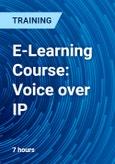This course provides an introduction to the systems that provide telephony services over networks that use the Internet Protocol (IP).
A useful primer for this course is the PTT course MEA: “Telephony systems”.
This course begins by explaining the advantages of Voice over IP (VoIP) systems with reference to the convergence of telecoms services. The basic principles of transporting voice samples over an IP network are explained with reference to the impairments that can degrade a VoIP service. The techniques employed to minimise the required bandwidth for a VoIP call are explained and the characteristics of various types of speech encoder compared. The significance of each of the various VoIP service parameters is also explained. The role of the signalling protocols SIP and H.323 are described and the function of the components of the networks that employ these protocols are explained. The role of the various SIP signalling messages are explained in various types of call set-up with reference to the relationship between SIP and the Session Description Protocol (SDP). The role of the various H.323 signalling messages are also explained in various types of call set-up.
This course should be studied as preparation for the more advanced PTT course MED: “VoIP systems”"
Course prerequisites:
You will get the most out of this course if you already understand the operation and use of the Internet protocols. It is recommended that TAF: "IP networks" is studied before attempting this course. Although not a pre-requisite, the study of TAH: "Advanced IP networks", would also aid the understanding of the transmission aspects of a VoIP service.
Course objectives:
By the end of this course you will be able to:
- explain the advantages of a Voice over IP (VoIP) service.
- describe the basic principles of carrying voice samples in IP packets.
- describe the effects of network impairments such as delay and jitter on a VoIP service and describe the techniques that reduce transmission delays.
- describe voice encoding and processing techniques inc. echo cancellation, compression and silence suppression.
- describe the characteristics of various encoder types.
- explain the factors that determine the bandwidth requirements of a VoIP service.
- describe the role of the signalling protocols SIP and H.323 and the functions of call servers and gateways.
- explain the significance of VoIP service parameters inc grade of service, availability and post-dial delay.
- describe the role and the relationship between the DiffServ, RSVP and MPLS protocols in providing an improved quality of service for VoIP calls.
- describe the components, protocols and operation of signalling systems using the Session Initiation Protocol (SIP).
- describe the role of the Session Description Protocol (SDP).
- describe the components, protocols and operation of signalling systems conforming to the ITU H.323 family of recommendations.
- explain how public telephony services can be provided using VoIP.
- describe the provision of VoIP telephony and video conferencing for businesses and explain some of the barriers to VoIP provision.
Course Content
The course consists of the following six modules:
Who Should Attend
Target audience:
This PTT online course is aimed at those responsible for the design or maintenance of Voice over IP systems.








